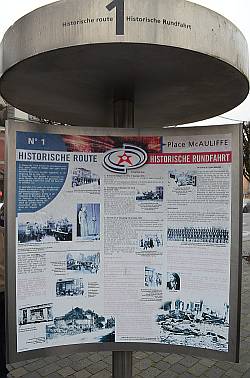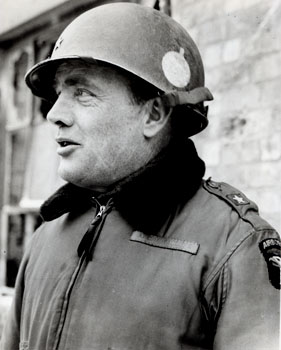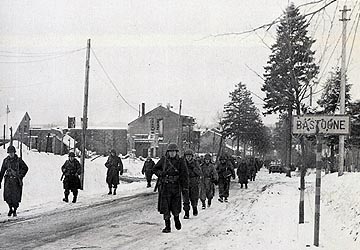Historical Route Bastogne 1
The Historical Route Bastogne is a route surrounding Bastogne with 15 information boards.
In September 1944, as everywhere in Belgium, the American troops are welcomed with open arms. Reinforcement troops are deployed in the vicinity of the city. In December 1944, the famous singer Marlene Dietrich visits the city, her presence is heartwarming for the soldiers.
The Battle of Bastogne, often referred to as the "von Rundstedt Offensive", is part of the Battle of the Bulge that started on December 16, 1944 and ended on February 6, 1945. For Bastogne, the battle ends on January 17, 1945.
1. The battle for Bastogne (from December 16 to 22, 1944)
The Germans and the Americans are trying to get hold of the important road junction. Commanded by Brigadier General Anthony C. McAuliffe, First Officer of the 101st Airborne, 18,000 Americans are surrounded.
2. The Siege of Bastogne (December 22-26, 1944)
Requested to surrender, McAuliffe replies with his famous saying "Nuts." Weather conditions allowed weapons and food to be dropped. The medical personnel reached the besieged with the help of gliders. The bombing of the Luftwaffe made Christmas Eve particularly difficult for the civilians and the besieged. De Sarma, a shop on the route de Neufchateau, was turned into a hospital for the many wounded.
3. The end of the encirclement (December 26, 1944)
General Patton's troops arrived via the Route d'Assenois and, with Lieutenant Boggess, established communication with the encircled garrison. To save the population from the danger of the bombing, the citizens were asked to leave the city and go to Neufchateau via the open corridor in the German encirclement. The nightly bombing of the "Luftwaffe" caused a lot of damage and 13 civilians died. The American officers met at the "place du Carrre" in front of Mr. and mrs. Lemaire and delegate authority to Mr. Jacqmin. Until January 17, the Germans and the Americans resisted the defense of their positions. Little by little, the corridor widens and the Germans are driven back to the border with the Grand Duchy of Luxembourg.
The tank on the "Place Général McAuliffe"
For a long time, this Sherman tank was considered one of the vehicles of General Patton's troops who came to liberate the city on December 26, 1944, i.e. the 4th Division. In reality, the tank belongs to the 11th Division and was brought to a stop in a muddy meadow at Renuamont (near Tillet), near the German positions in the village. Image M represents the company of which the tank crew were part at the time of their training in the United States. The full history of the tank, and especially that of its crew, is described in a book available at the Tourist Office (bilingual version French-English).
Renée Lemaire
A few steps from place McAuliffe, on rue de Neufchateau, there is a sign in memory of Renée Lemaire, nurse in Bastogne. She was employed by the US Army in the hospital that was set up in the shop and was killed in the bombing of the hospital after she managed to save a number of wounded.
To reach information board 2:
Follow the signs towards Houffalize-Liege keeping to the Route National. A little before the traffic light at Noville, on the right hand side, you should pull up close to the sign "Enclos des Fusillés".
Do you have more information about this location? Inform us!
Source
- Text: Historische Route Bastogne
- Photos: Jeroen Niels
Related books
Nearby
Museum
- 101st Airborne Museum Le Mess - Bastogne
- Bastogne Barracks (Headquarter Gen. McAuliffe) - Bastogne
- Bastogne War Rooms - Bastogne
Point of interest
- M4A3 Sherman Tank Bastogne - Bastogne
- Headquarters Heeresgruppe A Bastogne - Bastogne
- Historical Route Bastogne 8 - Bastogne
Monument
- Born of the Liberty Road - Kilometre 1145 - Bastogne
- Statue General McAuliffe - Bastogne
- Memorial Renée Lemaire & 10th Armored Division - Bastogne
Cemetery
- Belgian War Grave Bastogne - Bastogne
- German War Cemetery Recogne - Recogne (Bastogne)
- Belgian Graves Veterans Hompré - Hompré (Vaux-sur-Sûre)

















